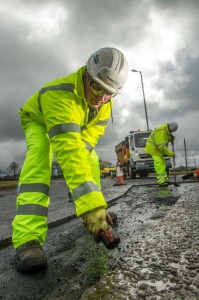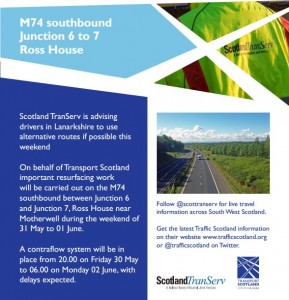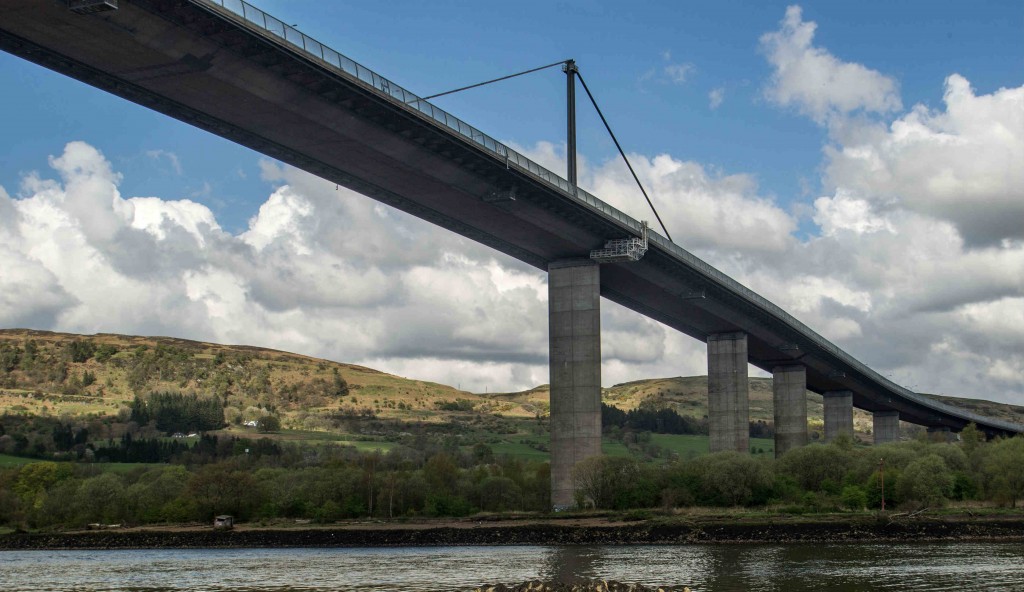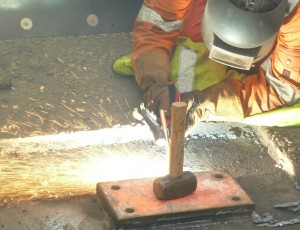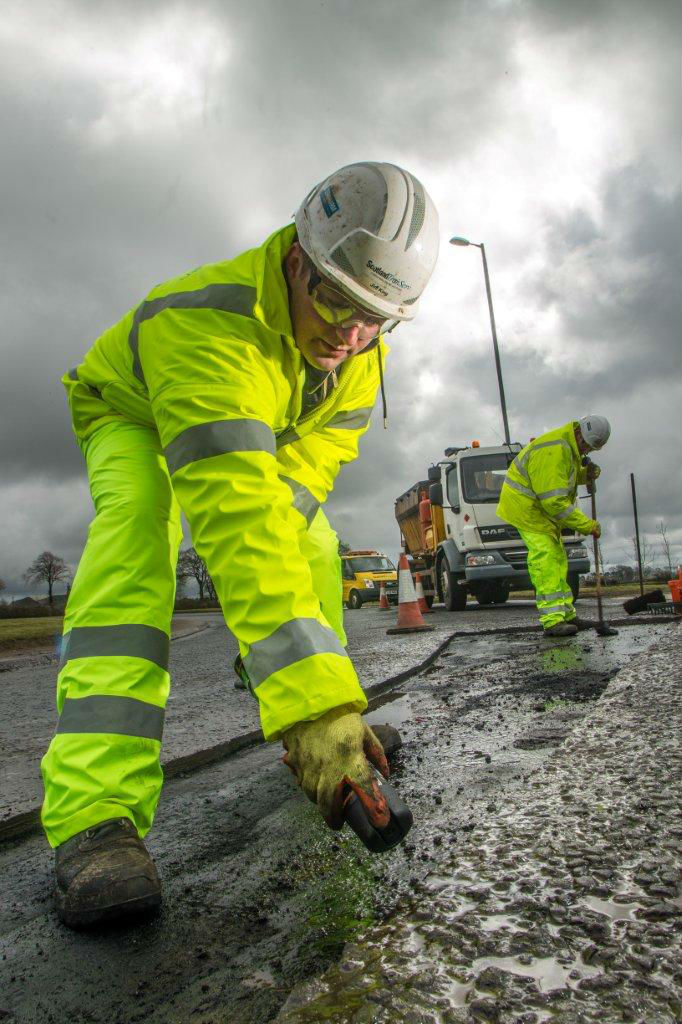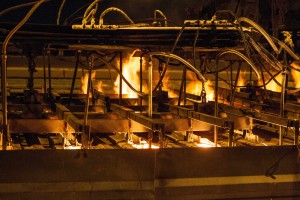A77 Old Street, Girvan resurfacing works
Road users will benefit from £82k of improvement works on the A77 Old Street, Girvan beginning 1 June 2014.
Scotland TranServ on behalf of Transport Scotland will carry out resurfacing works to improve the quality of the road surface for the years ahead.
Lane and parking restrictions will be in place daily between the hours of 09:00 and 16:00 from Monday 2 June to Wednesday 4 June. Traffic will be managed under a convoy system for the protection of the workforce and members of the public during these periods. A total road closure will be in place on Sunday 1st June 2014 from 09:00 to 16:00 (diversion details below).
Diversion - Sunday 1st June 2014 between 09:00 and 16:00 only
Southbound
Closure of A77 at Bridgemill Roundabout Girvan – take left onto B734 then turn right onto Coalpots Road Girvan – continue to Shallochpark Roundabout and take 2nd exit to rejoin the A77 southbound
Northbound
Closure of A77 at Shallochpark Roundabout – take right 2nd exit onto Coalpots Road – continue to junction with B734 – Turn left on to B734 – continue to Bridgemill Roundabout – take right 2nd exit to rejoin the A77 Northbound
Local access to Girvan at Shallochpark roundabout will be maintained at all times.
Breaking new barriers
Scotland TranServ, working on behalf of Transport Scotland is breaking new frontiers with the Vehicle Safety Barrier Replacement project on the Erskine Bridge.
Alongside contractor Highway Barrier Solutions (HBS), the Scotland TranServ project team worked to identify best practice and the safest possible solution for the 40,000 motorists crossing the bridge every day.
Scotland TranServ Project Manager, Colin Anderson said:
“It was about thinking out of the box, and looking at other areas of transport to identify the best and safest solution for Erskine Bridge drivers. Working with specialist consultants, Flint and Neill, we looked at railway safety barrier design and identified that when adapted, these might offer the best protection for both HGV drivers and for car drivers. The barriers were specially designed to cushion the impact of being hit at speed by a lorry, and that were they to be hit by a car they wouldn’t deflect the car across two lanes but more so slide it along the barrier and keep it in the same lane.
“One of the other issues we had to look at was the design of the bridge itself, and the weather conditions which also impact on the bridge. It can be really blustery up there and the last thing we wanted was for the barriers to add drag to the structure. That’s why we went to Denmark to test the design and a scale model of the bridge in a specialist wind tunnel for aerodynamics. A poor design could have ultimately threatened the structure of the bridge itself.”
These high containment barriers are specially designed to stop Heavy Goods Vehicles breaching the barrier at 50mph and at a 20° angle of impact. The design and construction team carried out full vehicle impact studies. The lower rail is designed such that it absorbs the impact and slides the car along the barrier rather than deflecting it into adjacent lanes, thus further improving safety.
Jerry Cutter from specialist consultants, Flint and Neill added:
“The Erskine Bridge replacement barrier development presented many challenges to the design team. The barriers needed to ensure that the bridge structure is protected from impact by heavy, errant vehicles whilst ensuring that the barriers would not present a danger to the occupants of vehicles of any size.
“The distance between the posts supporting the barriers needed to coincide with the internal walls of the bridge structure; this distance is greater than had been used elsewhere for this type of barrier which necessitated impact testing to demonstrate compliance with road barrier design standards. Wind tunnel testing was also necessary to assess the level of additional horizontal loading and also to confirm the bridge would remain stable in all wind conditions.”
There is also a sustainable element of the project, with miles of ageing, now redundant barriers removed, an environmentally-friendly solution had to be found for their disposal. Bridge contractors Highway Barrier Solutions (HBS) identified that.
Nigel Dougan HBS Director explains:
“This has been a successful project that has both challenged and inspired our specialist teams. Not only have we installed among the safest and most innovative vehicle safety barriers in the UK, but we have also removed and recycled mile upon mile of ageing metal barrier. This sustainability was an important element of the project and a further testament to the detailed consideration implemented at every step of this complex programme of work.”
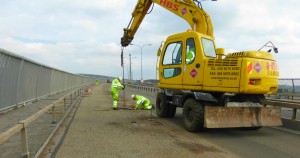 Throughout Scotland TranServ’s work, on behalf of Transport Scotland we are considering the environment and our long-term sustainability. From protecting rare birds and animal habitats beside our trunk roads, to the modern construction practices we use, Scotland TranServ considers its environmental impact at every stage.
Throughout Scotland TranServ’s work, on behalf of Transport Scotland we are considering the environment and our long-term sustainability. From protecting rare birds and animal habitats beside our trunk roads, to the modern construction practices we use, Scotland TranServ considers its environmental impact at every stage.
Scotland TranServ’s Environment Manager, Carol Walker said:
“Scotland TranServ is considering its impact on Scotland’s natural environment at every stage. We’re developing new methods to construct roads, reducing waste material and safely handling materials that have been used by our predecessors to construct the trunk roads network across the south west.
“By dealing with such issues on site we are also able to reduce our construction mileage, therefore reducing our carbon footprint and making our roads safer. Our sustainable civil engineering practices are benefiting road users by making construction more efficient and by supporting the natural environment of Scotland.”
The southbound Vehicle Safety Barrier Replacement work on the bridge was completed ahead of schedule last week.
Russell Rennie, Scotland TranServ’s Contract Director concluded:
“The health and safety of our workers and of the motoring public is of paramount importance to Scotland TranServ and everybody who works here. That is why we made every effort to ensure that we got the design exactly right in the first instance. We wanted these barriers to be as safe as they possibly could, and potentially save lives. The contract team worked with the manufacturer to specially develop these barriers for the purpose.
“Across the South West, Scotland TranServ is working on behalf of Transport Scotland to improve trunk road safety, road surfacing and the driver experience. It is important to us that we carry out our work as efficiently and effectively as possible, but at the same time that we consider the needs of drivers and neighbouring communities. We have made every effort to ensure that the Erskine Bridge Vehicle Safety Barrier Replacement project was carried out as quickly and efficiently as we could, with minimal disruption to drivers and to those communities living beside the bridge.”
Largs & Maybole Thank You
Scotland TranServ, on behalf of Transport Scotland would like to thank the communities of Largs and Maybole for providing their valuable opinions and insight at the recent consultation events.
Both events received a healthy turnout, ensuring that local views were recorded and incorporated into decision making process around the 20mph speed limit trial.
The consultation follows the recent review carried out by Transport Scotland into road safety and speed limits across the Scottish trunk roads network. The plans are part of a wider programme of measures to promote the safe and efficient use of Scotland’s roads.
Vincent Tait, Scotland TranServ’s Road Safety Manager said:
 “It was great to see so many local residents taking an active interest in road safety within their community. This is an important project and therefore it is essential that local people share their views. I’d like to thank everyone who took the time to find out more information and provide an opinion. Those still wishing to have an input can do so by contacting us by email, online or on the phone.”
“It was great to see so many local residents taking an active interest in road safety within their community. This is an important project and therefore it is essential that local people share their views. I’d like to thank everyone who took the time to find out more information and provide an opinion. Those still wishing to have an input can do so by contacting us by email, online or on the phone.”
ScotlandTranserv manages and maintains the A77 on behalf of Transport Scotland.
Should residents have missed the drop-in sessions, information about Transport Scotland’s 20mph speed limit trials is available at: www.transportscotland.gov.uk/speedlimittrials
Residents who were unable to attend the event can still contact Scotland TranServ to register their comments by e-mail at, [email protected].
For further information please contact our Customer Care Helpline on 0800 028 1414.
M74 s/b Jct 6 - 7 Ross House reminder
Scotland TranServ is reminding Lanarkshire drivers that extensive resurfacing works will be carried out on the M74 motorway on behalf of Transport Scotland this weekend.
The works will take place between Junction 6 and Junction 7 southbound at Ross House, from Motherwell to Larkhall.
A contraflow system will be put in place from 20.00 on Friday 30 May to 06.00 on Monday 02 June, with the bulk of the work taking place on Saturday the 31st May and Sunday 1st of June.
Again, those drivers who are able to reschedule their journey, or take an alternative route are advised to do so.
In order to inform as many drivers as possible we will be running a Local Radio and press campaign (see above right).
Russell Rennie, Scotland TranServ’s Contract Director added:
“Across south west Scotland we are delivering tangible benefits for drivers that will be felt for years to come, while supporting the economic growth and development of the region. In the last year, on behalf of Transport Scotland we have invested £40million to improve the quality of Scotland’s trunk roads and deliver a safer, more reliable driving experience. Our network carries more drivers than the other three quadrants combined.
“With Homecoming, the Commonwealth Games and the Ryder Cup, this is a big year for Scotland. We are doing everything possible to ensure that our network is in tip-top condition and that the M74 in particular, the gateway from the south is ready for the thousands of visitors who will flock to Glasgow and the south west for these showcase events.”
Live travel information will run throughout the weekend by following @scottranserv on twitter, or keeping up with the latest Traffic Scotland information through their website, www.trafficscotland.org or @trafficscotland.
Transport Minister welcomes bridge re-opening
Transport Minister Keith Brown is welcoming the completion of the bulk of the £6 million Erskine Bridge Vehicle Safety Barrier Replacement project, ahead of schedule.
Restrictions on the southbound carriageway were lifted ahead of peak morning commuter traffic, just a couple of months after the similar restictions on the northbound
carriageway were removed.
Mr Brown said:
“The Erskine Bridge is one of our busiest crossings and the Scottish Government has made this £6 million investment in its future to maintain transport links in West Central Scotland.
“It is very satisfying to see another transport project being delivered ahead of schedule and I am sure that the many people who use the Bridge will appreciate the cones being lifted this morning.
“I know that the work has caused delays and I want to thank people for the patience shown while the work was being carried out. The result, for us all, is a safer and upgraded bridge which will serve us well in future.”
The work is being carried out by Scotland TranServ and Highway Barrier Solutions on behalf of Transport Scotland.
Over the last ten months teams have undertaken carriageway repairs, and installed tower protection and new vehicle barriers in the verges and central reservation.
While there are still a number of minor works to complete such as centre line white lining and some smaller safety barrier replacements, both on the north side of the bridge. These will be scheduled for later in the summer and carried out during off peak times such as weekends and through the night in order to keep any further disruption to an absolute minimum. We will continue to keep the local community fully informed on the timings of these minor projects.
Russell Rennie, Scotland TranServ’s Contract Director added:
“This has been a challenging yet rewarding project and we are delighted with the performance of the Contractor, HBS who have taken the task in their stride and executed the works with extreme professionalism. We greatly appreciate the patience that the travelling public have shown while this important safety programme was carried out. We have continued to keep the local community informed throughout the project with regular updates to local community groups and media. These barriers will provide protection to both the public and the critical elements of the Bridge and we hope that drivers continue to appreciate their innovative safety elements for years to come.
“Across south west Scotland we are playing our part to improve the network and maintain around 2000 structures such as the Erskine and Kingston Bridges. This is an important time for Scotland and we continue to support the economic growth and development of the country by delivering robust, sustainable trunk road projects that will deliver tangible benefits to our customers, the motoring public for many years to come.”
Traffic flowing on both sides of Erskine Bridge
Traffic is this morning flowing on both sides of the Erskine bridge following the completion of the bulk of the £6 million Vehicle Safety Barrier Replacement project.
Over the last ten months teams have undertaken carriageway repairs, and installed tower protection and new vehicle barriers in the verges and central reservation, with the work completed ahead of schedule.
While Scotland TranServ has project managed and overseen the programme of work on behalf of Transport Scotland, the day-to-day work has been carried out by specialist contractor Highway Barrier Solutions (HBS).
HBS Director, Nigel Dougan, who has been ever-present on site said:
“This has been a challenging project, and one that has required innovative thinking. Our team has worked hard to ensure work was completed on time, and through some horrendous wintry conditions which made delicate operations, on top of such an exposed bridge, extremely difficult. This specialised work was carried out as efficiently and effectively as possible, but with the greatest concentration on safety. We hope that local drivers will appreciate this project for a very long time indeed.”
The high containment barriers have been especially designed to stop Heavy Goods Vehicles breaching the barrier at 50mph and at a 20° angle of impact. The design and construction team carried out full vehicle impact studies. The lower rail is designed such that it absorbs the impact and slides any impacting cars along the barrier rather than deflecting them into adjacent lanes, thus further improving safety.
The 10 month long project has been a collaboration between HBS and consultants Flint and Neill.
Flint and Neill Director, Jerry Cutter added:
“Much thought and effort went into the development of the solution that will now provide much better protection both for the bridge and for the bridge users. The Erskine Bridge replacement barrier development presented many challenges to the design team. The barriers needed to ensure that the bridge structure is protected from impact by heavy, errant vehicles whilst ensuring that the barriers would not present a danger to the occupants of vehicles of any size.
“The distance between the posts supporting the barriers needed to coincide with the internal walls of the bridge structure; this distance is greater than had been used elsewhere for this type of barrier which necessitated impact testing to demonstrate compliance with road barrier design standards. Wind tunnel testing was also necessary to assess the level of additional horizontal loading and also to confirm the bridge would remain stable in all wind conditions.”
Continued Investment in Inverclyde
On behalf of Transport Scotland, Scotland TranServ is investing more than a quarter of a million pounds to improve Inverclyde’s roads.
Work on seven projects will improve the quality of the region’s roads for years to come, delivering tangible benefits for local commuters, visitors and working drivers.
Brendan O’Sullivan, Scotland TranServ’s Area Network Programme Manager said:
“This is an important programme of work to improve the trunk roads network across Inverclyde. More than £250,000 is being invested to improve the surfacing at a number of local roundabouts and important trunks roads, which have received a battering from heavy traffic levels in recent years. We have made every effort to reduce disruption to local drivers throughout, and we would like to thank them for their patience while we deliver these long-term benefits.”
The projects were scheduled to avoid congestion, and included:
- A8 Cartsdyke roundabout, mid-April (overnight)
- A8 Cartsburn roundabout, mid-April (overnight)
- A8 Adjacent to Bay Street, Port Glasgow early May (overnight)
- A8 Pottery Street, mid-May (overnight)
- A8 Newark roundabout, 21-22 May (overnight)
- A78 East Shaw St roundabout late summer
- A78 Sir Michael St roundabout, late summer
Across south west Scotland, Scotland TranServ is delivering long-term benefits, scheduling road works to minimise the impact on the motoring public. Working on behalf of Transport Scotland, we are working to improve the quality of the trunk roads network from Loch Lomond to Loch Ryan (Stranraer).
Russell Rennie, Scotland TranServ’s Contract Director concluded:
“Scotland TranServ is delivering an important programme of investment across Inverclyde on behalf of Transport Scotland. To deliver more than a quarter of a million pounds investment in such a short period of time, shows both our commitment to the area and that of our client Transport Scotland. We continue to improve Inverclyde’s roads, delivering long-term benefits, supporting the economic growth and development of the region. The next few months will be important for Glasgow, with visitors taking in various locations across the area, including Inverclyde, the gateway to the stunning Clyde coast.”
Erskine Bridge Back in Business
Traffic will run on both sides of the Erskine Bridge this morning as the peak time restrictions put in place to allow the huge refurbishment of the crossing, are lifted ahead of schedule.
The bulk of the £6 million project, which is being carried out by Scotland TranServ and Highway Barrier Solutions on behalf of Transport Scotland is now complete.
Over the last ten months teams have undertaken carriageway repairs, and installed tower protection and new vehicle barriers in the verges and central reservation.
Transport Minister Keith Brown said:
“The Erskine Bridge is one of our busiest crossings and the Scottish Government has made this £6 million investment in its future to maintain transport links in West Central Scotland.
“It is very satisfying to see another transport project being delivered ahead of schedule and I am sure that the many people who use the Bridge will appreciate the cones being lifted this morning.
“I know that the work has caused delays and I want to thank people for the patience shown while the work was being carried out. The result, for us all, is a safer and upgraded bridge which will serve us well in future.”
Scotland TranServ’s Erskine Bridge Project Manager, Colin Anderson has managed the programme of work throughout.
Mr Anderson added:
“We are delighted that this project has been completed ahead of our original schedule. We know that this will mean a lot to the thousands of drivers who use the bridge on a daily basis as part of their commute to work. For them it has been a long 10 months, but we appreciate their patience while this vital safety programme was carried out.
“With a raft of measures including the construction of over 5km of one of the most innovative trunk road barriers in the country, the Erskine Bridge is now one of the safest such crossings in Scotland. This project will deliver long-term safety benefits which we hope local drivers will appreciate for many years to come as they head across the Clyde day after day.”
Deer, Oh deer!
Scotland TranServ, on behalf of Transport Scotland is appealing to drivers across South West Scotland to keep alert for the presence of young deer running onto our trunk roads.
At this time of year, accidents involving deer are more frequent, with the adolescent youngsters leaving their mothers in search of their own territories.
Jamie Hammond, Scottish Natural Heritage’s South Scotland deer management officer, said:
“Many people think most accidents with deer occur on remote Highland roads; in fact 70% occur on trunk roads or motorways. Accidents are particularly high in the spring and autumn because dusk and the peak commuting times coincide. Deer are more likely to be feeding near, or on, road verges at this time.
“We would advise motorists to slow down and watch for deer crossing in front of traffic. Be particularly alert if you are driving around curves or near heavily-forested areas where deer can suddenly appear before you have time to brake.”
Across South West Scotland this is most prevalent on the A701, A76, A75, A78, A77, A82, M77, M73, M74 and M8.
Carol Walker, Scotland TranServ’s Environment Manager said:
“This is an important time of year for young deer, when they finally leave their mothers and start to look for their own territory. They often find themselves wandering onto our trunk roads because they don’t have much of the necessary wisdom or experience to avoid them at that stage. The time of greatest risk is in the late evening, from sun down to the early hours of the morning when the deer are more active.”
Latest statistics reveal that there are 7000 collisions between motorists and deer every year in Scotland, with more than 60 of these resulting in injury to humans. Through injury and damage to vehicles this is costing the Scottish economy around £7million annually.
Malcolm Shanks, Scotland TranServ’s Operations Manager added:
“This isn’t just something that is reserved for the Highlands, more and more across south west Scotland we are hearing of accidents involving young deer. If you are driving near woodland, or past a large estate then please be vigilant. Even roadside barriers aren’t a hindrance for these animals, they can easily clear such hurdles. Hitting one of these young deer could not only injure it, but potentially injure you and cause significant damage to your vehicle.”
Dragon returns to its lair with lanes resurfaced
20 May 2014
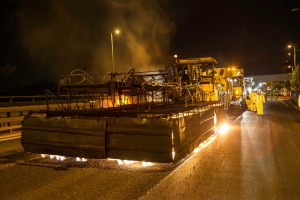
Paisley’s Flaming Dragon has returned to its lair after a week of major resurfacing work on the M8 Whitecart Viaduct.
The road construction vehicle worked lane by lane to replace the worn out surfacing on both eastbound and westbound carriageways of the M8, delivering an improved, safer, driving experience for commuters and visitors using Glasgow airport during this busy summer of events.
Philippa Ayton, Scotland TranServ’s Bridges Manager said:
“This is an exciting machine. Once the road has been planed, the Flaming Dragon heats the remaining surface to extreme temperatures, melting what’s left before blending it with fresh material to construct a new top layer. Because most of the surface is reconstituted it reduces the amount of waste. Normally more of the top layer would need to be removed and sent to landfill, but at Scotland TranServ, on behalf of Transport Scotland we’re working hard to maintain and improve our roads network using more sustainable methods.”
The specialist roads crews resurfaced an 800m stretch each night, working a lane at a time. In what was a huge logistical effort around 50 engineers worked nightly to improve the quality of the Whitecart Viaduct surface, delivering tangible benefits to local drivers. This section of the M8 is also one of the first impressions visitors to the city will get ahead of this summer’s Glasgow 2014 Commonwealth Games.
Russell Rennie, Scotland TranServ’s Contract Director said:
“First impressions count and that’s why, on behalf of Transport Scotland, we’re investing to improve the roads network along this stretch of the M8. Scotland TranServ has invested around £40million in the last year to improve and maintain the trunk roads network across south west Scotland, supporting the economic growth and development of the region. We’re delivering tangible benefits to our customers – the motoring public, that will last for many years to come.”





